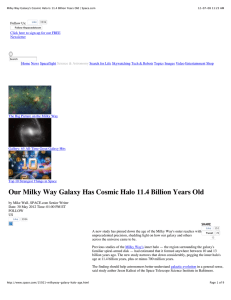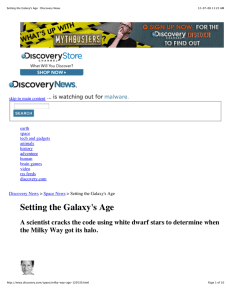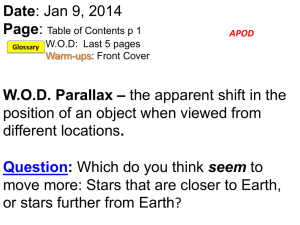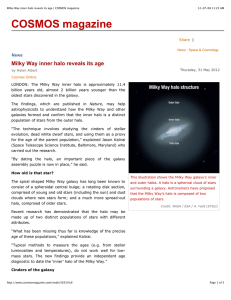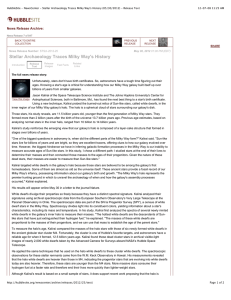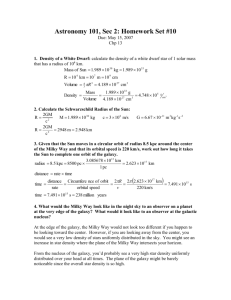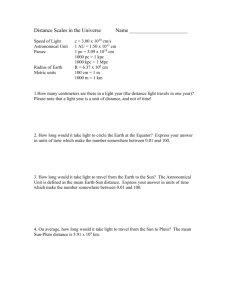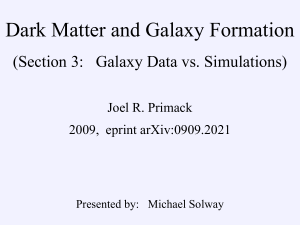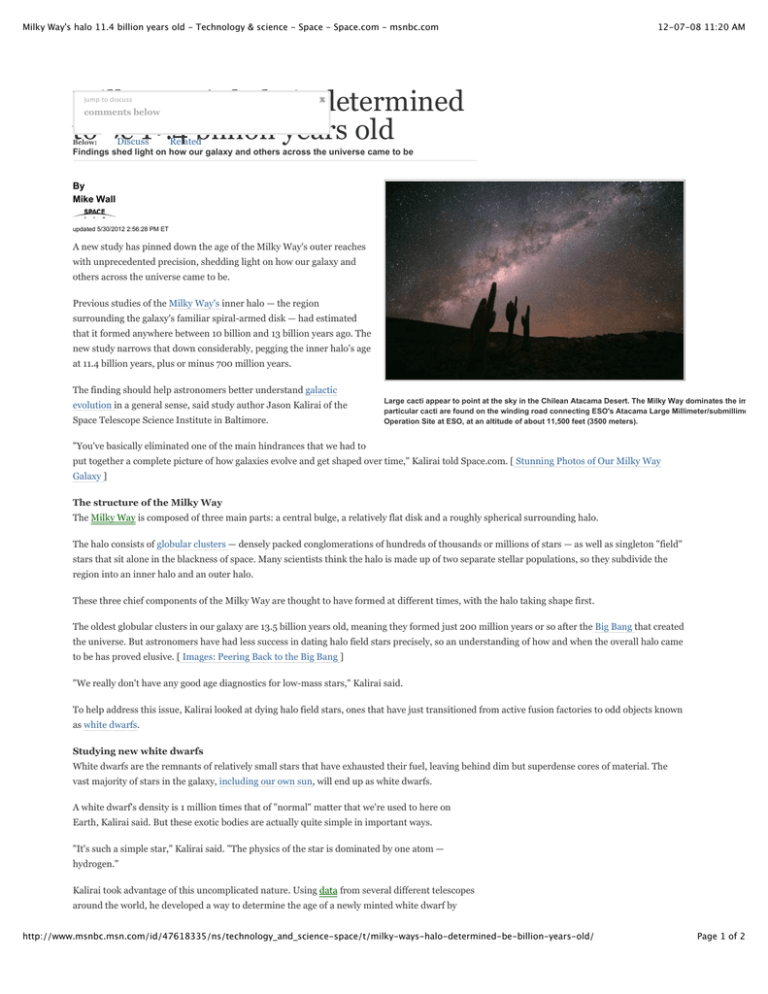
Milky Way's halo 11.4 billion years old - Technology & science - Space - Space.com - msnbc.com
12-07-08 11:20 AM
Milky Way's halo is determined
to be 11.4 billion years old
x
Jump to discuss
comments below
Below:
Discuss
Related
Findings shed light on how our galaxy and others across the universe came to be
By
Mike Wall
updated 5/30/2012 2:56:28 PM ET
A new study has pinned down the age of the Milky Way's outer reaches
with unprecedented precision, shedding light on how our galaxy and
others across the universe came to be.
Previous studies of the Milky Way's inner halo — the region
surrounding the galaxy's familiar spiral-armed disk — had estimated
that it formed anywhere between 10 billion and 13 billion years ago. The
new study narrows that down considerably, pegging the inner halo's age
at 11.4 billion years, plus or minus 700 million years.
The finding should help astronomers better understand galactic
evolution in a general sense, said study author Jason Kalirai of the
Space Telescope Science Institute in Baltimore.
Large cacti appear to point at the sky in the Chilean Atacama Desert. The Milky Way dominates the image, w
particular cacti are found on the winding road connecting ESO's Atacama Large Millimeter/submillimeter Ar
Operation Site at ESO, at an altitude of about 11,500 feet (3500 meters).
"You've basically eliminated one of the main hindrances that we had to
put together a complete picture of how galaxies evolve and get shaped over time," Kalirai told Space.com. [ Stunning Photos of Our Milky Way
Galaxy ]
The structure of the Milky Way
The Milky Way is composed of three main parts: a central bulge, a relatively flat disk and a roughly spherical surrounding halo.
The halo consists of globular clusters — densely packed conglomerations of hundreds of thousands or millions of stars — as well as singleton "field"
stars that sit alone in the blackness of space. Many scientists think the halo is made up of two separate stellar populations, so they subdivide the
region into an inner halo and an outer halo.
These three chief components of the Milky Way are thought to have formed at different times, with the halo taking shape first.
The oldest globular clusters in our galaxy are 13.5 billion years old, meaning they formed just 200 million years or so after the Big Bang that created
the universe. But astronomers have had less success in dating halo field stars precisely, so an understanding of how and when the overall halo came
to be has proved elusive. [ Images: Peering Back to the Big Bang ]
"We really don't have any good age diagnostics for low-mass stars," Kalirai said.
To help address this issue, Kalirai looked at dying halo field stars, ones that have just transitioned from active fusion factories to odd objects known
as white dwarfs.
Studying new white dwarfs
White dwarfs are the remnants of relatively small stars that have exhausted their fuel, leaving behind dim but superdense cores of material. The
vast majority of stars in the galaxy, including our own sun, will end up as white dwarfs.
A white dwarf's density is 1 million times that of "normal" matter that we're used to here on
Earth, Kalirai said. But these exotic bodies are actually quite simple in important ways.
"It's such a simple star," Kalirai said. "The physics of the star is dominated by one atom —
hydrogen."
Kalirai took advantage of this uncomplicated nature. Using data from several different telescopes
around the world, he developed a way to determine the age of a newly minted white dwarf by
http://www.msnbc.msn.com/id/47618335/ns/technology_and_science-space/t/milky-ways-halo-determined-be-billion-years-old/
Page 1 of 2
Milky Way's halo 11.4 billion years old - Technology & science - Space - Space.com - msnbc.com
12-07-08 11:20 AM
analyzing its hydrogen emissions.
Kalirai realized that these emissions, analyzed properly, reveal the white dwarf's mass and other
important characteristics, which can then be used to estimate how old the object was when it
made the switch from active star to dying dwarf.
He calibrated the technique by studying the spectra of newly formed white dwarfs — identified by
their temperature — in the globular cluster Messier 4, which has a known age of about 12.5 billion
years. Once he confirmed that the method works, Kalirai looked at four stars in the inner halo
that have just become white dwarfs.
Studying these four yielded an age of 11.7 billion years, plus or minus 700 million, for the inner
halo field. The results — which are much more precise than previous inner-halo age estimates,
Kalirai said — were published Wedneday in the journal Nature.
"This new chro!nometer provides a means to determine the ages of stellar populations in the halo,
and will increase our knowledge of how and where the galaxy’s stars have formed and evolved,"
Timothy Beers, of the Kitt Peak National Observatory and the National Optical Astronomy
Observatory in Tucson, Ariz., wrote in an accompanying perspectives piece in Nature.
Understanding the Milky Way
Hubble Space Telescope images of white dwarfs in NGC 6397. Young white dwa
were found far away from the center of the globular cluster, where they were
expected to be found.
An age of 11.7 billion years for the inner halo makes a certain amount of sense. The outer halo is thought to be slightly
More space news from msnbc.com
older, after all, and the most ancient galaxy clusters suggest that the Milky Way's building blocks began coming together
around 13.5 billion years ago or so.
Kalirai plans to look at newly minted white dwarfs in the outer halo to get an age for the field stars in that region. And he
also wants to study more dwarfs in the inner halo, so he can get a better idea of how long it took the stars there to form.
The new technique can't be directly applied to other galaxies, since white dwarfs so far away are too dim for their spectra
to be studied in detail. But the results should still help astronomers understand fundamentals of galactic evolution that
hold beyond our own Milky Way, Kalirai said.
Crew selected for
food's final frontier
Science editor Alan Boyle's blog:
Researchers have chosen six
"gastronauts" who will put outerspace menus to the test next
year during a four-month
simulated Mars mission in
Hawaii.
"If you know the age of the inner halo forming, you're constraining something more general about the ways galaxies form,"
Fireworks spotted by space telescopes
he said.
Solar flare hits a new high for the summer
Hints of life on Mars just below surface?
You can follow Space.com senior writer Mike Wall on Twitter: @michaeldwall. Follow Space.com for the latest in space
science and exploration news on Twitter @Spacedotcom and on Facebook.
The Big Picture on the Milky Way
Gallery: 65 All-Time Great Galaxy Hits
Top 10 Strangest Things in Space
© 2012 Space.com. All rights reserved. More from Space.com.
More from msnbc.com
From around the web
New Zealand told to hunker down for major earthquake
Study: Fructose May Improve Diabeticsʼ Blood Sugar Control (ScienceDaily)
Witness: Cady Way teens naked, bound at gunpoint
Learn how to grill an amazing baked potato (Schwan's)
Afghan Taliban publicly execute woman accused of adultery; men cheer
13 Facts You Did Not Know About Walking as Exercise--Are You Doing
It Right? (HealthCommunities.com)
Brawling over health care moves to rules on exchanges
Malware Internet Threat Could Strike Thousands Monday
[what's this]
Teenage girl posts picture of cash on Facebook, family robbed within
hours (Digital Trends)
Unplug your charger (Recyclebank)
http://www.msnbc.msn.com/id/47618335/ns/technology_and_science-space/t/milky-ways-halo-determined-be-billion-years-old/
Page 2 of 2

